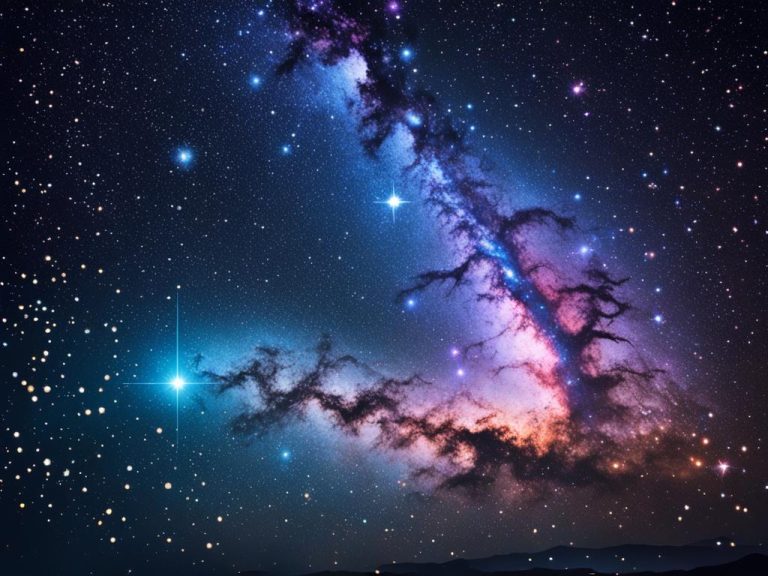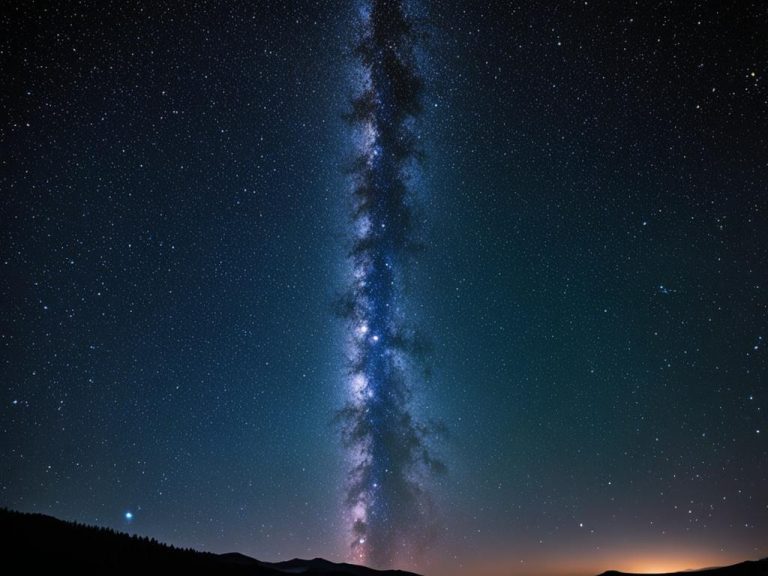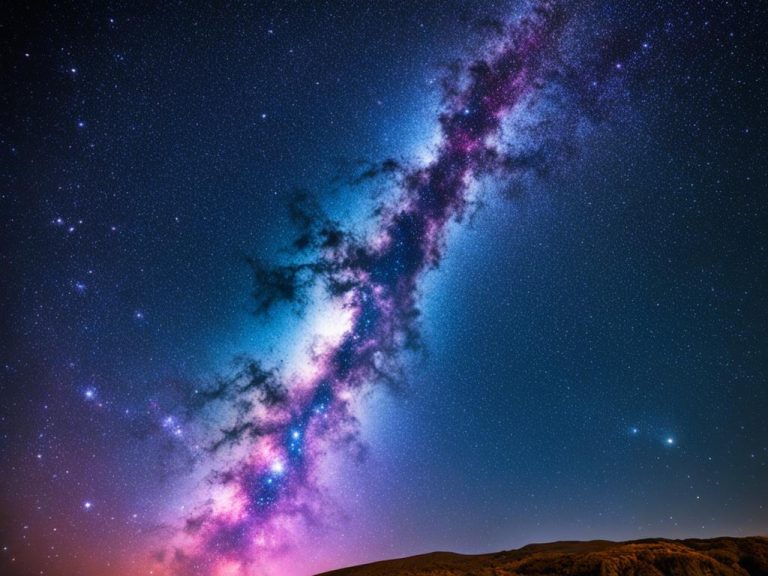Navigate the Stars: Sextans Constellation Guide
Did you know the Sextans constellation holds the most distant galaxy cluster we know of? It’s big, covering 314 square degrees, and full of amazing sights. This group of stars is faint but catches the eye with its celestial wonders. It’s a great find for anyone interested in the sky or outer space.

Key Takeaways:
- Introduced in the 17th century by Johannes Hevelius, Sextans sits in the sky’s south, near Hydra, Crater, and Leo.
- Among its features are the Spindle Galaxy and several other galaxies, a distant galaxy cluster, and a notable galaxy called Cosmos Redshift 7.
- It boasts the bright star Alpha Sextantis, the closest star to us, and hosts planets beyond our solar system too.
- The constellation is quite large, easy to spot at certain latitudes, and is a known part of ancient tales, adding to its mystique.
- Learn about Sextans’ stories, its role in the night sky, and the special things linked to this part of the stars.
The Mythological Origins of Sextans Constellation
Sextans is different from other constellations. It doesn’t come from any specific myth. Its name comes from a historical link to scientific tools. Johannes Hevelius named it after the sextant, an instrument for measuring stars.
Hevelius used it to find star positions. The original name was Sextans Uraniae. But his observatory burned down, and it got the simpler name Sextans.
This name was accepted by the International Astronomical Union. It’s part of the list of modern constellations today.
If you’re interested to know more, check these resources:
- Find detailed information on constellation Sextans at Wikipedia.
- Explore the universe with a guide to the Sextans constellation provided by Universe Guide.
- Discover the celestial wonders of Sextans through the constellation guide on Sea and Sky.
Notable Stars in Sextans Constellation
Sextans constellation has stars that draw in astronomers and fans of the night sky. One bright star stands out, known as Alpha Sextantis. It glows with a magnitude of 4.49, making it the most shiny one in Sextans.
Only 10 parsecs (about 32.6 light years) away, Sextans has five close stars. Bibhā (HD 86081) and Gnomon (WASP-43) are two stars with special names. They make Sextans extra interesting.
Sextans boasts five stars that host exoplanets, sparking more interest. Exoplanets circle around these stars, including one hot Jupiter near WASP-43 found in 2011.
Notably, there’s a unique dance in Sextans with two planets around 24 Sextantis. These planets have a special 2:1 orbit rhythm.
Even though Sextans lacks Messier objects, it has other heavenly delights. The Spindle Galaxy (NGC 3115) is bigger than the Milky Way and has a supermassive black hole. William Herschel found it on February 22, 1787.
For more on Sextans stars, check out the Sextans constellation guide.Wikipedia’s star list for Sextans also has detailed data.
The constellation Sextans is a beautiful part of our night sky, full of different and exciting stars.
Deep Sky Objects in Sextans Constellation
Sextans constellation has many cool deep sky objects. The Spindle Galaxy (NGC 3115) is a favorite. It’s a lenticular galaxy that’s about 31.6 million light years away. It has a unique shape and a clear bulge in the middle. This makes it a great find for anyone looking at the stars.
Besides the Spindle Galaxy, there are others in Sextans. Two spiral galaxies, NGC 3166 and NGC 3169, catch the eye. They’re part of the Leo I Group. NGC 3169 has spiral arms wrapped tightly. NGC 3166 is different, with an off-balance look. Looking at these can teach us about how galaxies change over time.
Sextans also has irregular galaxies like Sextans A and B. Sextans A, or LEDA 36252, is small and not shaped like a normal galaxy. Sextans B, known as LEDA 3087792, is shaped by stars still forming. They help us learn how bigger galaxies and smaller ones might work together.
There’s a big group of galaxies here too – CL J1001+0220. It has many galaxies all pulled close together by gravity. Studying clusters like this one helps us see how the universe’s structure and the life of galaxies change over time.
Sextans is also where we found the Cosmos Redshift 7 galaxy (CR7). It’s about 12.9 billion light years away, making it one of the oldest and farthest galaxies we know. Finding CR7 has told us a lot about how the universe began, including the birth of the first stars and galaxies.
If you’re curious about Sextans’ deep sky objects, you can look up images. They show just how amazing and complex these celestial wonders in Sextans are.

Summary:
- The Spindle Galaxy (NGC 3115) is a lenticular galaxy and one of the most famous objects in Sextans constellation.
- Other notable deep sky objects in Sextans include the spiral galaxies NGC 3166 and NGC 3169, the irregular galaxies Sextans A and Sextans B, the galaxy cluster CL J1001+0220, and the Cosmos Redshift 7 galaxy.
- Exploring these objects offers fascinating opportunities for observation and study, providing insights into galaxy evolution, large-scale structure, and the early universe.
- Online Sextans constellation images showcase the captivating beauty and complexity of these celestial wonders.
Locating Sextans in the Night Sky
To see the Sextans, know where to look in the night sky. Look for it in summer from both hemispheres. It is near the celestial equator, so everyone can spot it easily.
Find Sextans near the Hydra, Crater, and Leo stars. Use just your eyes or add binoculars or a telescope. These tools help reveal its beauty since it is quite dim.
The best time to see Sextans is in summer when it’s high in the sky. Keep an eye out for when it’s at its top. This boosts your chance of enjoying its beauty.
Ready for your stargazing trip? Get a star map or an astronomy app. They show where to find the Sextans. Now you’re all set to explore the universe.
Spotting Sextans leads you to an amazing universe journey. Its mystery will amaze you, showing what’s beyond our world.
International Star Registry and Naming a Star in Sextans Constellation
Want to celebrate the beauty of Sextans constellation? One way is by naming a star there. International Star Registry lets you Buy a Star for Someone and Name a Star After Someone. You can do this by visiting their website at starregistry.com. There, pick a star in Sextans or any other constellation. It will be officially recorded in their star catalog.
This gift allows you to make a lasting connection to Sextans. It’s perfect for birthdays, weddings, anniversaries, or any big event. Naming a star is a special gesture that will last a lifetime.
How it Works
It’s easy to name a star in Sextans. Just visit International Star Registry’s website. Then follow the simple steps to pick and name your star. This makes your gift very personal. After you buy a star package, you’ll get a certificate and a star map. They show exactly where your star is in Sextans.
You can also choose extras like calligraphy and photo charts. These make your gift even more unique. They ensure your present stands out and is remembered.
Celebrities with stars named in this constellation is a favorite among celebrities. Some celebrities that have their very own stars named in Sextans include Johnny Carson and Valerie Harper.
Facts and Size of Sextans Constellation
Sextans is part of the many constellations we see in the night sky. While not as big as others, it is still interesting. This constellation covers an area of 314 square degrees. It ranks as the 47th largest. You can find it in the southern hemisphere’s second quadrant. It’s one of the 15 constellations near the equator.

Unlike some constellations with very bright stars, Sextans doesn’t have any stars brighter than 3.00 in magnitude. But, it is special because it has five stars within 10 parsecs or 32.6 light years from us. These stars are part of our close cosmic neighborhood.
The name Sextantis is used for Sextans when talking about star names. Its short form is Sex. This naming helps astronomers and fans find and know stars in this area of the sky easily.
Sextans Constellation’s Astronomical Significance
Sextans constellation is important in astronomy, despite being faint. It’s close to the celestial equator. This means people in both hemispheres can see it sometimes.
In Latin, Sextans means a sextant, a tool for navigation. In English, it’s called “The Sextant.” Astronomers often shorten it to “Sex” or “Sext.”
The genitive form of its name is “Sextantis,” showing its link to the sextant device.
Sextans has special sky events and key objects. It’s home to the furthest galaxy cluster known, CL J1001+0220. Also, the galaxy Cosmos Redshift 7 shows us stars from right after the Big Bang.
Several stars in Sextans have planets orbiting them. These include HD 86081 and WASP-43. Studying these planets helps us learn about different planetary systems.
In Sextans, star brightness varies. None shine very bright. Alpha Sextantis is the brightest, with a magnitude of 4.49.
Sextans also has known galaxies. These include Sextans A, Sextans B, and the Black Eye Galaxy. It’s a favorite for studying galaxies.
The constellation was named by Johannes Hevelius in the 17th century. He used the Sextans Uraniae symbol in his star maps.
Sextans is not just about stars. It influences language and symbolizes certain beliefs. For example, the Hindu lotus with six petals represents Sextans’ meaning in culture and religion.
Learn more about Sextans and its impact with these sources:
- The Sextans Constellation – The Sky
- Sextans Constellation – Astronomy.com
- Sextans – Constellations of Words
The Relationship between Sextans and Other Constellations
The Sextans constellation is from the family of Hercules. This group also includes constellations like Aquila and Lyra. The night sky shows us its amazing beauty.
Sextans is in the south and is famous for its star cluster. This open cluster of stars shines brightly. It is in the Sextans Astronomical Group with galaxies, forming a unique part of our view of space.
Sextans and its neighbors create a special view in the sky. Together, they show us nature’s grand design. Looking up, we see how they are all connected, full of wonder and secrets.
The Daytime Meteor Shower and Other Phenomena in Sextans
Exploring Sextans is awesome. We find unique things like daytime meteor showers. In late October and early November, the Sextantids happen, but you won’t see them at night. This makes them a special challenge to spot.
Sextans doesn’t have the classic beautiful sky objects others do. These are named after French astronomer Charles Messier. But, this doesn’t make it any less interesting. The constellation is still a wonder to look at.
Other Phenomena in Sextans
Sextans stands out in its own way. It has bright stars that are truly fascinating. Looking at these stars lets us see how big and amazing the universe is.
Next, we will learn more about the special stars in Sextans. This will show why exploring Sextans is so cool.
- Learn about the stars that make Sextans shine
- Discover the historical and scientific significance of these stars
- Unveil their unique features and characteristics
Conclusion
Exploring the Sextans constellation is magical. It’s like a journey through the night sky’s wonders. Sextans shows off stars, deep sky objects, and more. It gives a unique sky view for both stargazers and anyone who loves the night.
The Spindle Galaxy shines bright in Sextans. It has exoplanets – planets outside our solar system too. Sextans invites us to look at its amazing sights with awe.
Looking for a special gift? Think about International Star Registry. By naming a star in Sextans, you can make a memory last forever. Visit starregistry.com to learn more. You can give a gift that truly stands out.
FAQ
What is the Sextans constellation?
The Sextans constellation is faint and in the sky’s south. It’s named after a sextant, a tool used by Johannes Hevelius. It’s found between Hydra, Crater, and Leo.
Are there any notable stars in the Sextans constellation?
Indeed, Alpha Sextantis is the brightest star in this constellation. LHS 292 is also here, the closest star to us in Sextans.
How can I locate Sextans in the night sky?
Sextans is between Hydra, Crater, and Leo in the night sky. It looks best during the summer and is close to the celestial equator.
How can I name a star in the Sextans constellation?
Naming a star in Sextans or elsewhere is easy. Just visit International Star Registry’s website. They let you name a star for someone special.
What is the astronomical significance of Sextans?
Sextans holds the title for the most distant known galaxy cluster and the Cosmos Redshift 7 galaxy. This galaxy shows stars soon after the Big Bang. Plus, it has stars with exoplanets, offering insights into other solar systems.
How is Sextans related to other constellations?
Are there any meteor showers associated with Sextans?
The Sextantids meteor shower is linked to Sextans. However, it happens during the day, making it hard to see.
Source Links
- Constellations in the Sky Tonight – https://www.constellation-guide.com/
- Stars, Story, Facts, Location – Constellation Guide – https://www.constellation-guide.com/constellation-list/sextans-constellation/
